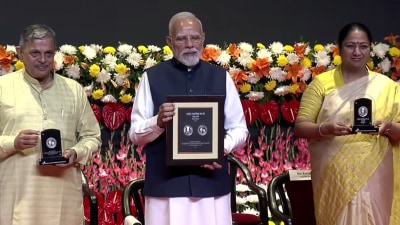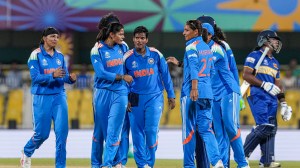ICC: Robbing Peter to pay Paul
As the wise men of the ICC sit in Dubai and plot, over the next two days, the game’s immediate future, they would do well to remember h...

As the wise men of the ICC sit in Dubai and plot, over the next two days, the game’s immediate future, they would do well to remember how much the game currently owes India and Indian cricketers. And then devise a system of contracts that would not punish excellence — as ambush marketing seems to do, by robbing Peter to pay Paul — but reward it.
In college, we were taught about the economic drain from India. How the English levied heavy taxes to fund their establishments, their armies and their wars, transporting home the raw material from India back home and bringing back finished goods to dump in the oversized Indian market. How, in the process, local infrastructure remained undeveloped.
Today, the International Cricket Council (ICC) is attempting to do something similar to Indian cricket. The attempt is to milk the cash-rich Indian cricket market and, with that, feed the rest of the world. This is nothing but a clever attempt by the ICC to create a level financial playfield for all countries and players under the guise of ‘‘ambush marketing’’. By offering unusual protection to sponsors from competitors, the ICC has managed to raise a little extra money for itself and distribute it among member nations who could otherwise only envy India’s cricket wealth. The first protests about the unfair clauses pertaining to image use and endorsements came from overseas players, not Indians, who explained that they had no conflicting endorsements — their objection was issue-based.
This issue became clear soon enough when, in a somewhat syncrhonised manner, their boards cleverly offered 25 to 30 per cent of their participation revenue to cricketers as appeasement. The cricketers also accepted it in the spirit of the game. And the Indian players earned themselves the anti-national tag when they didn’t fall in line.
The draconian ‘‘ambush marketing’’ clause is a new form of lagaan that has been imposed to fund international cricket. As has now become clear, such protection exists in no other sport. Several sponsors have also gone on record to say that they had not asked for these clauses, that they agreed to pay a bit more because this clause was offered.
What if the clause wasn’t there? Knock off 25 per cent from the sponsorship fees and most sponsors would live happily without such privileges. The GCC, in turn, can proportionately reduce its US $550 million commitment to the ICC, which further can reduce the participation fees to the respective boards. The respective boards need not complain either, as they wouldn’t have to pay the 25 to 30 per fees to their players as compensation any more. Where’s the problem?.
Overseas cricketers often complain that they don’t have any commercial endorsements to match those of their rich Indian cousins. The most lucrative endorsement for Steve Waugh, the most successful captain of late, is that from MRF. Can somebody explain why David Beckham makes several million pounds annually and our own Baichung Bhutia a measly Rs 30 lakh? Simple. Football in England is of a higher standard, which simply breeds bigger stars and, in turn, greater corporate and public patronage.
Why hasn’t FIFA tried to put such draconian restrictions on footballers, raising the sponsorship and TV rights fees by putting a blanket ban on endorsements by football stars and distribute the monies globally? Cricket is to India what football is to England. The game gets more money and the players get more money than anywhere else does in the world. The Indian cricketers are not demanding any extra payments for playing, unlike the overseas cricketers who have demanded more money from their boards. The Indians only want to retain their commercial rights just like any other sportsmen in other international sport.
The issue is not about Tendulkar, Ganguly or Dravid; they have already earned most of what they would. The problem is about the youngsters who will be deprived of an opportunity to earn and about those who will succeed the present crop. And please don’t tell us that the solution lies in contracting junior players to bondage by making them accept these terms at an early age.
Indeed, ‘‘ambush marketing’’ will have a serious impact on the future of cricket in India. For a game to grow you need big stars, who get compensated for their special skills. It doesn’t require any special intelligence to understand why youngsters aspire to become cricketers and not hockey players: Cricket compensates better.
This clause will lead to an all-round decline of investment in Indian cricket if it goes through. Most sponsors will find cricket a bad option once they realise that they have limited use to stars. An endorsement is not about just the fees paid to cricketers. Several promotional activities, especially at school level, follow.
The Indian cricket industry’s clout can be seen in the sales pattern of the ICC events. So far the sales by GCC have been in the region of $400 million, including commitments for the entire seven-year period as well as deals specifically for the Champions Trophy and the World Cup. Interestingly, all long-term deals — Sony, Pepsi, LG — are India-centric. While Pepsi and LG have paid around $25 million each for the association, the biggest is the deal with Sony Entertainment Television (SET), who’ve acquired the satellite rights for a whopping $255 million.
Then there’s the lesser association of Hero Honda and Doordarshan. Add these and you have a figure close to $325 million — almost 80 per cent of the total sales so far. Ask these companies why they have placed such huge sums on these events and, without batting an eyelid, they will reply ‘Because of India’. Take India out and the ICC’s events will fall flat on their face. Forget $550 million, the ICC will not be able to raise even half that amount. In fact, even less than that as SET alone accounts for 46 per cent of the ICC’s revenue.
World cricket needs India today. For any cricket event to succeed the magic mantra is to invite India. See how Sharjah has lost both its reach and clout ever since the Indian government blocked Indian team’s participation. With India’s participation come the big bucks. The television rights for the Indian market fetch the highest prices and almost all the sponsorships originate from here. The Board of Control for Cricket in India must realise its strength and not allow ICC to bully it into submission. The reality is that the ICC dare not isolate BCCI.



- 01
- 02
- 03
- 04
- 05




























